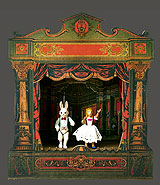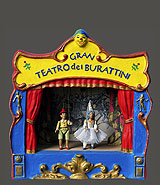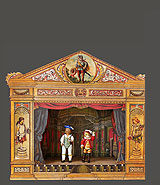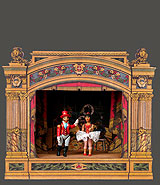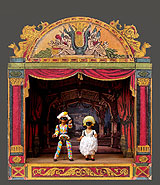PAPER THEATRES: A SPACE FOR IMAGINATION
Since XVIII century paper theatres have represented a window open onto at a world of wonders and imagination.
Before the spread of paper theatres, dioramas (motionless three-dimensional perspective images) had been quite popular. Among the most interesting dioramas and prospects it’s worth mentioning the ones made by Martin Engelbrecht in Germany, around the year 1760.
In the same period, in Europe, the publishing of prints dedicated to theatres started to gain ground; mostly, the prints portrayed actors in costumes and poses referring to the theatrical events of the time.
The paper theatres developed from the combination of printed characters dressed in stage costumes and dioramas. In the second half of the nineteenth century, the production of small theatres and marionettes became quite popular: the images, etched on copperplates, were printed on paper, cut out, glued on cardboard or wood , fretted and finally assembled.
The small theatres represented a microcosm set apart from the real world; a variety of printed and coloured sheets of paper to cut out and assemble entered the market and the middle class houses as a sort of fascinating entertainment for children and adults.
In many European countries the publishers took on artists and keen designers to draw the models both of the sceneries and the characters; the images were often sold by a publisher to another one, copied, modified and so on.
The production of the small paper theatres as well as their characters increased and the styles became more and more various and imaginative.
In Italy, most of the paper theatres with printed prosceniums, wings and backdrops drew inspiration from the local tradition of mobile marionettes made of wood, terracotta or plaster.
The characters of Commedia dell’ Arte have always been very popular and represented in a large number of prints.
Finally, the circus with its exotic animals and fanciful characters enriched the scenery.
The paper marionette and the cardboard silhouette have remained almost the same as in the past: the most popular one is Harlequin that whirls and does acrobatics while tied up between two wooden sticks.
Step by step, paper theatres have represented a variety of subjects, images and characters which transform actors and audience into “travellers of imagination”.
MUSIC BOX THEATRES
MICRO THEATRES
SOUVENIR THEATRES
DISPLAY THEATRES "MICRO MARIONETTESS"
SMALL THEATRES "MICRO MARIONETTESS"
MEDIUM / BIG THEATRES "BIG MARIONETTESS"
DISPLAY THEATRES "BIG MARIONETTESS"
